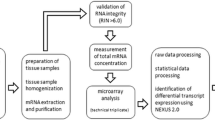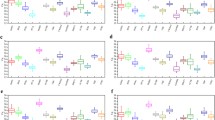Abstract
Transcriptional dosimetry is an emergent field of radiobiology aimed at developing robust methods for detecting and quantifying absorbed doses using radiation-induced fluctuations in gene expression. A combination of RNA sequencing, array-based and quantitative PCR transcriptomics in cellular, murine and various ex vivo human models has led to a comprehensive description of a fundamental set of genes with demonstrable dosimetric qualities. However, these are yet to be validated in human tissue due to the scarcity of in situ-irradiated source material. This represents a major hurdle to the continued development of transcriptional dosimetry. In this study, we present a novel evaluation of a previously reported set of dosimetric genes in human tissue exposed to a large therapeutic dose of radiation. To do this, we evaluated the quantitative changes of a set of dosimetric transcripts consisting of FDXR, BAX, BCL2, CDKN1A, DDB2, BBC3, GADD45A, GDF15, MDM2, SERPINE1, TNFRSF10B, PLK3, SESN2 and VWCE in guided pre- and post-radiation (2 weeks) prostate cancer biopsies from seven patients. We confirmed the prolonged dose-responsivity of most of these transcripts in in situ-irradiated tissue. BCL2, GDF15, and to some extent TNFRSF10B, were markedly unreliable single markers of radiation exposure. Nevertheless, as a full set, these genes reliably segregated non-irradiated and irradiated tissues and predicted radiation absorption on a patient-specific basis. We also confirmed changes in the translated protein product for a small subset of these dosimeters. This study provides the first confirmatory evidence of an existing dosimetric gene set in less-accessible tissues—ensuring peripheral responses reflect tissue-specific effects. Further work will be required to determine if these changes are conserved in different tissue types, post-radiation times and doses.




Similar content being viewed by others
References
Amundson SA, Lee RA, Koch-Paiz CA, Bittner ML, Meltzer P, Trent JM, Fornace AJ Jr (2003) Differential responses of stress genes to low dose-rate gamma irradiation. Mol Cancer Res 1(6):445–452
Amundson SA, Grace MB, McLeland CB, Epperly MW, Yeager A, Zhan Q, Greenberger JS, Fornace AJ Jr (2004) Human in vivo radiation-induced biomarkers: gene expression changes in radiotherapy patients. Cancer Res 64(18):6368–6371
Anders S, Pyl PT, Huber W (2015) HTSeq—a Python framework to work with high-throughput sequencing data. Bioinformatics 31(2):166–169
Barker HE, Paget JTE, Khan AA, Harrington KJ (2015) The tumour microenvironment after radiotherapy: mechanisms of resistance and recurrence. Nat Rev Cancer 15(7):409–425
Begg AC, Stewart FA, Vens C (2011) Strategies to improve radiotherapy with targeted drugs. Nat Rev Cancer 11(4):239–253
Boldt S, Knops K, Kriehuber R, Wolkenhauer O (2012) A frequency-based gene selection method to identify robust biomarkers for radiation dose prediction. Int J Radiat Biol 88(3):267–276
Brengues M, Paap B, Bittner M, Amundson S, Seligmann B, Korn R, Lenigk R, Zenhausern F (2010) Biodosimetry on small blood volume using gene expression assay. Health Phys 98(2):179–185
Brzoska K, Kruszewski M (2015) Toward the development of transcriptional biodosimetry for the identification of irradiated individuals and assessment of absorbed radiation dose. Radiat Environ Biophys 54(3):353–363
Budworth H, Snijders AM, Marchetti F, Mannion B, Bhatnagar S, Kwoh E, Tan Y, Wang SX, Blakely WF, Coleman M, Peterson L, Wyrobek AJ (2012) DNA repair cell cycle biomarkers of radiation exposure inflammation stress in human blood. PLoS One 7(11):e48619
Edmondson DA, Karski EE, Kohlgruber A, Koneru H, Matthay KK, Allen S, Hartmann CL, Peterson LE, DuBois SG, Coleman MA (2016) Transcript analysis for internal biodosimetry using peripheral blood from neuroblastoma patients treated with (131)I-mIBG, a targeted radionuclide. Radiat Res 186(3):235–244
Eisenberg E, Levanon EY (2013) Human housekeeping genes, revisited. Trends Genet 29(10):569–574
Fenech M (2011) Current status, new frontiers and challenges in radiation biodosimetry using cytogenetic, transcriptomic and proteomic technologies. Radiat Meas 46(9):737–741
Filiano AN, Fathallah-Shaykh HM, Fiveash J, Gage J, Cantor A, Kharbanda S, Johnson MR (2011) Gene expression analysis in radiotherapy patients and C57BL/6 mice as a measure of exposure to ionizing radiation. Radiat Res 176(1):49–61
Forrester HB, Sprung CN (2014) Intragenic controls utilizing radiation-induced alternative transcript regions improves gene expression biodosimetry. Radiat Res 181(3):314–323
Ghandhi SA, Smilenov LB, Elliston CD, Chowdhury M, Amundson SA (2015) Radiation dose-rate effects on gene expression for human biodosimetry. BMC Med Genom 8:22
Grace MB, Blakely WF (2007) Transcription of five p53- and Stat-3-Inducible genes after ionizing radiation. Radiat Meas 42(6):1147–1151
Kabacik S, Mackay A, Tamber N, Manning G, Finnon P, Paillier F, Ashworth A, Bouffler S, Badie C (2011) Gene expression following ionising radiation: identification of biomarkers for dose estimation and prediction of individual response. Int J Radiat Biol 87(2):115–129
Keam SP, Caramia F, Gamell C, Paul PJ, Arnau GM, Neeson PJ, Williams SG, Haupt Y (2018a) The transcriptional landscape of radiation-treated human prostate cancer: analysis of a prospective tissue cohort. Int J Radiat Oncol Biol Phys 100(1):188–198
Keam SP, Gulati T, Gamell C, Caramia F, Huang C, Schittenhelm RB, Kleifeld O, Neeson PJ, Haupt Y, Williams SG (2018b) Exploring the oncoproteomic response of human prostate cancer to therapeutic radiation using data-independent acquisition (DIA) mass spectrometry. Prostate 78(8):563–575
Koussounadis A, Langdon SP, Um IH, Harrison DJ, Smith VA (2015) Relationship between differentially expressed mRNA and mRNA-protein correlations in a xenograft model system. Sci Rep 5:10775
Langmead B, Salzberg SL (2012) Fast gapped-read alignment with Bowtie 2. Nat Methods 9(4):357–359
Li MJ, Wang WW, Chen SW, Shen Q, Min R (2011) Radiation dose effect of DNA repair-related gene expression in mouse white blood cells. Med Sci Monit 17(10):BR290-7
Little JB, Azzam EI, de Toledo SM, Nagasawa H (2002) Bystander effects: intercellular transmission of radiation damage signals. Radiat Prot Dosimetry 99(1–4):159–162
Lucas J, Dressman HK, Suchindran S, Nakamura M, Chao NJ, Himburg H, Minor K, Phillips G, Ross J, Abedi M, Terbrueggen R, Chute JP (2014) A translatable predictor of human radiation exposure. PLoS One 9(9):e107897
Mori R, Wang Q, Danenberg KD, Pinski JK, Danenberg PV (2008) Both beta-actin and GAPDH are useful reference genes for normalization of quantitative RT-PCR in human FFPE tissue samples of prostate cancer. Prostate 68(14):1555–1560
O’Brien G, Cruz-Garcia L, Majewski M, Grepl J, Abend M, Port M, Tichy A, Sirak I, Malkova A, Donovan E, Gothard L, Boyle S, Somaiah N, Ainsbury E, Ponge L, Slosarek K, Miszczyk L, Widlak P, Green E, Patel N, Kudari M, Gleeson F, Vinnikov V, Starenkiy V, Artiukh S, Vasyliev L, Zaman A, Badie C (2018) FDXR is a biomarker of radiation exposure in vivo. Sci Rep 8(1):684
Paul S, Amundson SA (2008) Development of gene expression signatures for practical radiation biodosimetry. Int J Radiat Oncol Biol Phys 71(4):1236–1244
Paul S, Barker CA, Turner HC, McLane A, Wolden SL, Amundson SA (2011) Prediction of in vivo radiation dose status in radiotherapy patients using ex vivo and in vivo gene expression signatures. Radiat Res 175(3):257–265
Riecke A, Rufa CG, Cordes M, Hartmann J, Meineke V, Abend M (2012) Gene expression comparisons performed for biodosimetry purposes on in vitro peripheral blood cellular subsets and irradiated individuals. Radiat Res 178(3):234–243
Ritchie ME, Phipson B, Wu D, Hu Y, Law CW, Shi W, Smyth GK (2015) limma powers differential expression analyses for RNA-sequencing and microarray studies. Nucleic Acids Res 43(7):e47
Schaue D, Micewicz ED, Ratikan JA, Xie MW, Cheng G, McBride WH (2015) Radiation and inflammation. Semin Radiat Oncol 25(1):4–10
Torgovnick A, Schumacher B (2015) DNA repair mechanisms in cancer development and therapy. Front Genet 6:157
Tucker JD, Joiner MC, Thomas RA, Grever WE, Bakhmutsky MV, Chinkhota CN, Smolinski JM, Divine GW, Auner GW (2014) Accurate gene expression-based biodosimetry using a minimal set of human gene transcripts. Int J Radiat Oncol Biol Phys 88(4):933–939
Author information
Authors and Affiliations
Contributions
SK, SW, PN and YH conceived and designed the study. SK designed and performed the experiments and analysed and the data. TG, CG, GMA and CH assisted with experimental design. SK and FC designed and performed the bioinformatics analyses. RS and OK designed and performed mass spectrometry and analysed the data. SK drafted the manuscript. SK, SW and YH critically revised the manuscript.
Corresponding author
Ethics declarations
Conflict of interest
We have no conflicts of interest to disclose.
Ethics approval and consent to participate
All participants provided consent covering tissue research as part of a prospective tissue collection study for prostate radiobiology research approved by the Human Research Ethics Committee at the Peter MacCallum Cancer Centre (PMCC; HREC approvals 10/68 and 13/167).
Availability of data and material
The datasets used and/or analysed during the current study are available from the corresponding author on reasonable request.
Electronic supplementary material
Below is the link to the electronic supplementary material.
Rights and permissions
About this article
Cite this article
Keam, S.P., Gulati, T., Gamell, C. et al. Biodosimetric transcriptional and proteomic changes are conserved in irradiated human tissue. Radiat Environ Biophys 57, 241–249 (2018). https://doi.org/10.1007/s00411-018-0746-5
Received:
Accepted:
Published:
Issue Date:
DOI: https://doi.org/10.1007/s00411-018-0746-5




